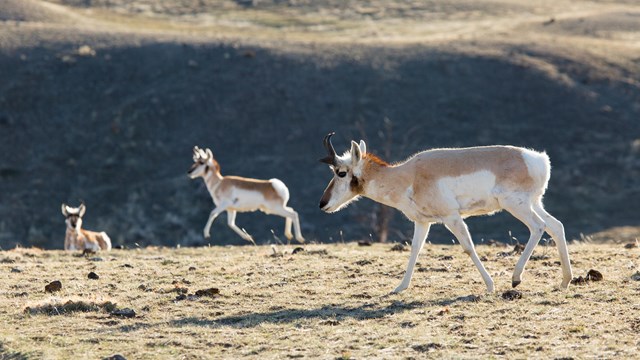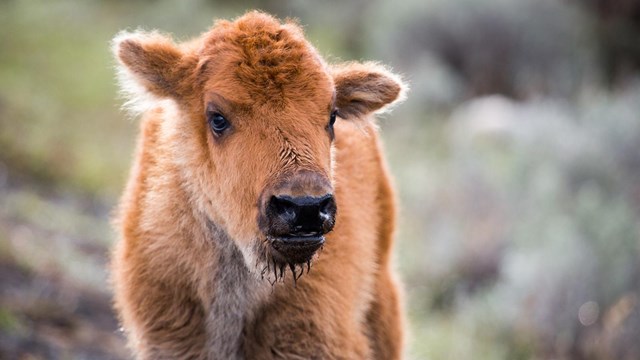
NPS / Jacob Frank Yellowstone moose are the smallest of four subspecies of moose (Alces alces shirasi) in North America. Found in forested areas and willow flats from southeastern British Columbia to southern Colorado, they are better adapted to survival in deep snow than other ungulates in Greater Yellowstone. Except during the rut, moose are usually found alone or in small family groups. This behavior, and their use of habitat where they are often well concealed, impedes accurate estimates of population size and distribution. DescriptionMoose are the largest members of the deer family in Yellowstone. Both sexes have long legs that enable them to wade into rivers and through deep snow, to swim, and to run fast. Moose, especially cows with calves, are unpredictable and have chased people in the park. Moose are dark brown, often with tan legs and muzzle. Bulls have antlers for most of the year, or pedicles (flat bony protrusions on the skull) in the winter after antlers are cast. Females are distinguished from bulls without antlers by the white patch beneath their tail. Adults of both sexes have “bells”—a pendulous dewlap of skin and hair that dangles from the throat. Bulls urinate in wallows and lay down and splash in it spreading the scent all over them. The dewlap holds the scent that is then dispersed by the wind. In summer, moose eat aquatic plants like water lilies, duckweed, and burweed. But the principle staples of the moose diet are the leaves and twigs of the willow, followed by other woody browse species such as gooseberry and buffaloberry. In winter when available, moose exhibit a high preference to subalpine fir. An adult moose consumes approximately 10–12 pounds of food per day in the winter and as much as 50 pounds of food per day in the summer. Some moose that summer in the park migrate in winter to lower elevations west and south of Yellowstone where willow remains exposed above the snow. But many moose move to higher elevations (as high as 8,500 feet) to winter in mature stands of subalpine fir and Douglas-fir. During the rut, both bulls and cows are vocal. Cows emit a drawn out groan in search of a mate, and bulls challenge one another with low guttural and repetitive grunts before clashing with their antlers. The weaker bull usually gives up before any serious damage is done; on rare occasions the opponent’s antlers inflict a mortal wound. Bulls usually shed their antlers in late December to late January, although young bulls may retain their antlers as late as March. Shedding their heavy antlers helps moose conserve energy and promotes easier winter survival. In April or May, bulls begin to grow new antlers. Small bumps called pedicles on each side of the forehead start to swell, then enlarge until they are knobs covered with a black fuzz (called velvet) and fed by blood that flows through a network of veins. Finally, the knobs change into antlers and grow until August. The antlers are flat and palmate (shaped like a hand). Yearlings grow six- to eight-inch forked antlers; prime adult bulls usually grow the largest antlers—as wide as five feet from tip to tip. When the antlers reach their full size, the bull rubs his antlers on small trees and brush to remove the velvet and polish the antlers in preparation for the rut. Cows breed in early fall; gestation is approximately eight months. Cows most commonly give birth to a single calf in Yellowstone. PopulationMoose appear to have been scarce in Yellowstone until the latter half of the 1800s and in Jackson Hole until the early 1900s. The first documented report of a moose on the northern range was 1913. Predator control programs, forest-fire suppression, and restrictions on moose hunting contributed to their subsequent range expansion and increased numbers. Forest-fire suppression was probably the most important factor in moose population increase because moose in Greater Yellowstone depend on mature spruce/fir forests for winter survival, unlike other North American moose populations that prefer large willow flats or shrubland that has been created by events like fires or logging. The Yellowstone moose population has declined from roughly 1,000 in the 1970s to about 200 in 1996 (the most recent data), with the northern range population down by at least 75% since the 1980s. The population declined steeply following the fires of 1988 that burned mature fir forests. Many old moose died during the winter of 1988–89, probably as a combined result of the loss of good moose winter forage and a harsh winter. Large populations of elk and bison, which also browse willow, likely reduce the amount of willow forage available for moose. Unlike moose habitat elsewhere, northern Yellowstone does not have woody browse species that will come in quickly after a fire and extend above the snowpack to provide winter food. Recent studies south of the park also suggest that fire on the summer ranges of migratory moose is partially responsible for the population decline. The population of moose that uses burned areas is declining more rapidly than the portion of the population that forages in unburned areas. Predation of moose calves by bear and wolf populations may be limiting population growth, but the low pregnancy rates of greater Yellowstone moose suggest limits set by food availability. Long-term studies suggest that North American moose populations tend to erupt, crash, and then stabilize for a time. Predation of moose calves by bear and wolf populations may be continuing to limit population growth, but the low pregnancy rates of Greater Yellowstone moose suggest limits set by food availability. Longterm studies suggest that North American moose populations tend to erupt, crash, and then stabilize for a time. Montana has noted a state-wide decline in moose populations. Moose hunting in the districts immediately north of Yellowstone has been limited to antlered bulls since 1996. Only two permits were issued in those districts in 2014. In 2012, Montana Fish, Wildlife and Parks began a study to assess and monitor the population across the state. A three-year northern Yellowstone National Park moose study was recently completed between the winters of 2013–2014 and 2015–2016 with the main objective to estimate population abundance and vital statistics of northern Yellowstone moose. Population modelling based on fecal DNA estimated between 150 and 186 moose occupied northern Yellowstone between 2013 and 2015 and that the annual populationgrowth rate is 4%, (considered moderate growth). However, because mature conifer forest (important wintering habitat) were reduced by the 1988 fires and large populations of elk and bison compete with moose for willow browse, northern YNP moose will likely persist at a low density. Today, moose are most likely seen in the park’s southwestern corner and in the Soda Butte Creek, Pelican Creek, Lewis River, and Gallatin River drainages. ResourcesBarmore, W.J. Jr. 2003. Ecology of ungulates and their winter range in Northern Yellowstone National Park, Research and Synthesis 1962–1970. Yellowstone Center for Resources. Becker, S.A. 2008. Habitat selection, condition, and survival of Shiras moose in northwest Wyoming In Department of Zoology and Physiology. M.S. University of Wyoming. Tyers, D.B. and L.R. Irby. 1995. Shiras moose winter habitat use in the upper Yellowstone River Valley prior to and after the 1988 fires. Alces 31:35–43. Tyers, D.B. 2008. Moose population and history on the northern Yellowstone winter range. Yellowstone Science 16. |
Last updated: April 18, 2025


